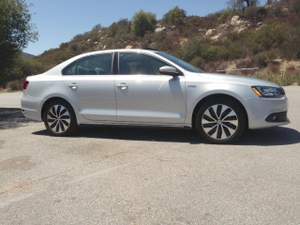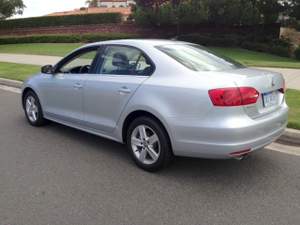

Tale of Two Turbos: Hybrid vs. Diesel – Blurred Lines
Okay, let’s get this said early – diesel and hybrid owners are not looking for the same thing in a car. VW believes that and we think they’re on the right track. Oh sure, both buyers want a quality vehicle that delivers high fuel economy, but there is something very different in their reason for choosing one of the two vehicles, according to VW’s market research. However, having the opportunity to drive the 2013 Jetta Hybrid and Jetta TDI back-to-back for a couple of weeks, I think the line between the two is pretty blurred.
Each car was fun to drive with good comfort and plenty of power, especially the TDI, which, when tromped-on was a blast. More on this later. Let’s start with what VW has accomplished with these two cars – excellent fuel economy.
Jetta Hybrid: Quiet and Smooth
The 2013 Jetta Hybrid is rated at 42 City/48 Highway with an average of 45 mpg. In my week of driving, which included about a third in-town and had me going from sea level to 4,700 feet on a 107º day (thanks VW for great A/C!) and plenty of jammed SoCal freeways, I averaged 41 mpg. The front wheel drive hybrid, powered by a 1.4-liter turbocharged and intercooled gasoline (91 octane) engine and a 20 kw electric motor, are mated to VW’s seven-speed, dual-clutch Tiptronic automatic transmission. This combination generates a maximum 150 hp (at a high 5,000 rpm) with 184 lb-ft torque at 1,600 rpm. These two power sources make for smooth, fast acceleration with no turbo lag at any speed.
The VW hybrid system is constantly evaluating your driving style and based on the demand being asked of the car, it seamlessly switches between gasoline and electric including a nice option being able to drive up to 44 mph on electricity only when selecting “E-Mode.” They even have a “Sailing” mode where at freeway speeds the car runs on the electric motor if it senses a constant speed, the road is flat and the engine isn’t needed. VW so wants you to be in gasoline-saving mode that the Stop-Start feature kicks in and the Jetta is now cruising (Sailing) at freeway speeds on pure electricity. Turn-off the stereo and this is one very quiet ride. A light tap on the accelerator pedal turns on the engine again without any noticeable segue between the two.
And if you want to have some real fun, let me introduce you to the “Boost” mode. This is when cruising along in the gasoline engine and the need – or urge – to floor it invites the electric motor to join in and – Hello torque – off you go! I have to admit that just playing with the Boost was an enjoyable part of driving the hybrid and probably contributed to my getting less mpg than the EPA estimate. No hypermiling here.
Interior
I was driving the fully optioned Jetta Hybrid SEL Premium. The interior fit and finish were German tight, with a good mix of soft and hard plastics and no unnecessary fake woods or plastic chrome pieces. The heated leather front seats were comfortable (with a 6-way partial power driver’s seat) and, combined with the adjustable steering wheel/column, Fender sound system developed with Panasonic, power moonroof/sunroof and rearview camera, made for a pleasant experience behind the wheel. The Sirius/XM option is always a guilty pleasure and other than the touch screen system taking some time to get used to, it all worked well.

The 60/40 rear folding seat with a ski pass-through opening provides a large storage capacity that is only slightly compromised by the 1.1 kwh battery positioned over the rear wheels. A few interior observations that are worth noting: If you like to sit low in the driver’s seat then your arm/elbow cannot rest on the top of the door panel, forcing you raise the seat higher than you might prefer. I also thought the center console was too wide as my right leg was pushed against it in the normal driving position, the sun visors could benefit from a wider and longer finger slot, and wondered why VW did not use rocker switches for the outside electric mirror adjustment and to operate the sunroof. Instead they use hockey puck shaped knobs that, while they work fine, detract from the sleek look of the rest of the interior. Plus I thought the pushbutton Stop/Start button and electric accessory dock were in odd places – both on the center console facing up.
Minor points, but as I said, worth noting.
Exterior
The exterior of the hybrid has some styling features that differentiate it from the other Jetta models to increase aerodynamics and reduce wind resistance:
- a closed front upper fascia,
- underbody trays and side skirts and rear spoiler (the latter two also available on the GLI).
Overall, I liked the Jetta exterior styling with its clean lines and no useless cladding. VW calls this “class-up appeal” in which they offer more for less. I agree.
The Driving Experience
The 2013 Jetta Hybrid is quiet and smooth making for a very enjoyable driving experience. The SEL Premium model I was driving had 17” wheels and all-season tires, which provided good handling via the strut-type front suspension with coil springs and the multi-link, coil springs and anti-roll bar on the rear. Body roll was almost non-existent even when pushed above the recommended corner speed limits on some twisties I found in the SoCal mountains.
The Tiptronic transmission provides the option to manually shift when getting sporty and it worked like it should. One curious thing – why have this option and not provide a tachometer?
A good handling car of course is nothing without good brakes. The Jetta comes standard with discs all around, with vented fronts, and I experienced no fade with straight stops. The car comes with ABS, but here in Southern California where it has not rained in years, I will assume they work as advertised.
As mentioned earlier, the SEL Premium came with a 6-way adjustable, heated driver’s seat, which I was able to position in a comfortable driving position. At 5’ 9” I fit in all cars, including open wheel racers, so a true test was having a 6’ 1” associate sit in the driver’s seat and, when positioned, climb into the back to check leg, knee and head room. The Jetta accommodated my friend in comfort with room to spare for me in back.
And I can’t leave without mentioning the Bi-Xeron headlights that lit the road as bright as anything I have seen. This alone is worth considering the SEL Premium upgrade package.
2013 Jetta Hybrid MSRP
Base (Special Order) $25,815
SE $28,080
SEL $30,665
SEL Premium $32,265
Note: Prices are based on most recent Internet-posted information and include destination charge (your local prices will vary, just like your fuel economy).
Jetta TDI: Powerful and Economical
The main difference in the Jetta TDI from the Hybrid is obvious when starting the car: you can hear it. The very distinctive diesel rumble is low in volume but, make no mistake, it is there. This just may be enough to keep some people from considering it over the gasoline or hybrid versions. But before doing so, give the TDI a lengthy test drive at your local dealer and you probably will find you can easily live with it.
The TDI model I drove was nicely equipped with Bluetooth, Sirius/XM and leatherette seats, which were comfortable, looked good and stood-in nicely for a more expensive leather version. But what my car had that was unexpected was a 6-speed manual transmission.
The manual has short throws with an easy-to-get-used-to clutch. There was no grinding and only one stall, when I forgot I was not driving an automatic – as I had been doing the previous week in the Jetta Hybrid. There is an Upshift light in the speedometer cluster that, if you follow it, reduces the fun of driving this car is reduced significantly. Of course doing so will maximize the fuel economy, especially when the light wants you to be in 6th gear at 45 mph. However, the TDI’s true economy comes at freeway speeds. In 6th, for example, at 80 mph the tach reads 2,000 rpm. Volkswagen rates the car at 30 City/42 Highway with 34 mpg average. In my 510 miles of 1/3 city and 2/3 highway I averaged 36.6 mpg and that included having some fun.
So what kind of fun can you have in the TDI with a manual? Well, this car, when asked, has instant, fast, push-you-back-in-your-seat torque that brings a big smile to your face. The driving experience might have been better had I had the Premium model with the 17” wheels.
Sales
Volkswagen has 75% of the passenger vehicle diesel sales in the USA and is #1 in sales versus diesel competitors. And there is little on the competitive horizon to knock VW off that perch especially since they will have a new TDI engine and additional diesel models coming in 2014.
2013 Jetta TDI MSRP
Base w/ Manual $24,015
Base w/ Auto $25,115
Premium w/ Manual $25,675
Premium w/ Auto $26,775
Premium w/ Manual & Navigation $27,135
Premium w/ Auto & Navigation $28,235
Note: Prices include destination charge and are based on current Internet postings at www.vw.com. Your prices will vary.

Observations: 2013 Jetta Hybrid vs. 2013 Jetta TDI
Way back at the beginning of this review I noted that diesel and hybrid owners have very different reasons for owning each vehicle. After my back-to-back drives, I will suggest that anyone considering a Jetta hybrid for its environmental statement also add the diesel to your shopping list.
The hybrid gets better fuel economy, rides smoother, is quieter and fun to drive, especially when the Boost mode kicks-in. But the diesel engines of 2013 burn clean, are smoke-free, get very good fuel economy and offer a torque/acceleration experience found on more expensive cars.
So which to buy? You will have to run the numbers of an approximate $2,000 base price premium for the hybrid against the number of miles you drive and of course, your personal needs. If you drive mostly in the city or with significant freeway stop-and-go traffic, then making the hybrid investment may well be worth your while. If you do mostly open freeway driving, then the diesel will deliver mpg in the high 40 range, which is oh so great.
You will not go wrong with either decision and of course – Happy Driving!
Story and photos by John Faulkner

11 thoughts on “Comparison Road Test: 2013 Volkswagen Jetta Hybrid vs. 2013 Jetta TDI”